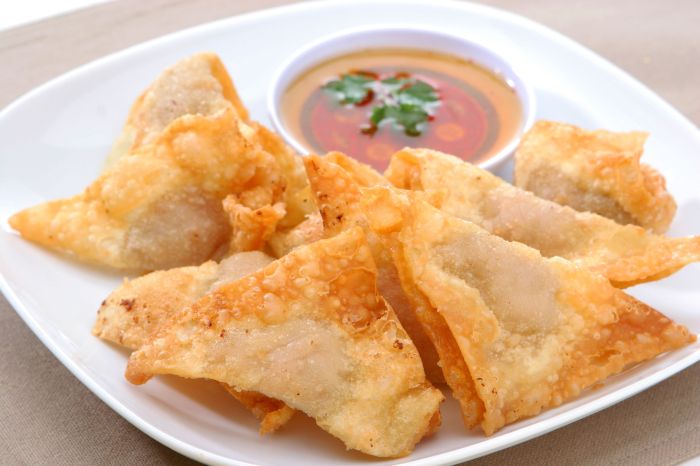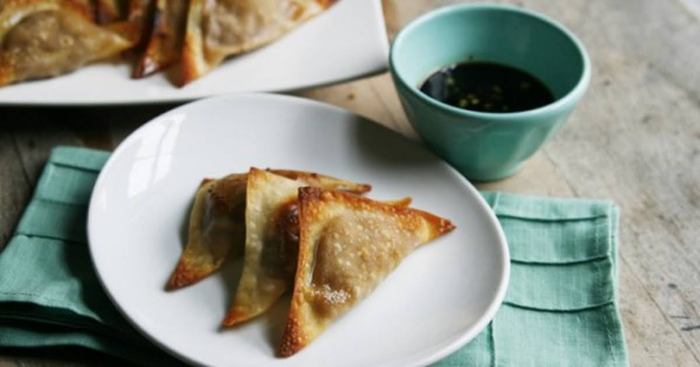Crab Wonton Sauce Recipe A Culinary Guide
Crab Wonton Sauce Recipe Variations
This section explores three distinct crab wonton sauce recipes, each offering a unique flavor profile: sweet and sour, spicy, and savory. We’ll delve into the key ingredients, cooking methods, and a comparison of these variations to help you choose the perfect sauce for your culinary creation.
Sweet and Sour Crab Wonton Sauce
This recipe balances sweet and tangy notes, creating a delightful contrast to the richness of crab. The key ingredients work together to achieve this balance. Pineapple juice provides sweetness and acidity, while rice vinegar adds a sharp tang. Cornstarch helps thicken the sauce to a desirable consistency.
- In a saucepan, combine ½ cup pineapple juice, 2 tablespoons rice vinegar, 1 tablespoon soy sauce, 1 tablespoon sugar, and 1 teaspoon cornstarch.
- Whisk until the cornstarch is fully dissolved.
- Bring the mixture to a simmer over medium heat, stirring constantly.
- Continue to simmer until the sauce has thickened, about 2-3 minutes.
- Stir in ½ cup cooked crab meat and remove from heat.
Spicy Crab Wonton Sauce
This version infuses a fiery kick with the addition of chili garlic sauce and sriracha. The careful balance of spice and other flavors is crucial. The ginger adds a subtle warmth that complements the spiciness, while the garlic provides a pungent aroma.
- In a small bowl, whisk together 2 tablespoons soy sauce, 1 tablespoon chili garlic sauce, ½ tablespoon sriracha, 1 teaspoon grated ginger, and 1 clove minced garlic.
- In a separate saucepan, heat 1 tablespoon of oil over medium heat.
- Add the sauce mixture to the saucepan and bring to a simmer.
- Simmer for 2-3 minutes, or until slightly thickened.
- Stir in ½ cup cooked crab meat and remove from heat.
Savory Crab Wonton Sauce
This recipe highlights the natural savory flavors of crab meat with a touch of umami. Oyster sauce and sesame oil contribute to a rich, complex flavor profile. The green onions provide a fresh, vibrant counterpoint.
- In a small saucepan, combine 2 tablespoons oyster sauce, 1 tablespoon sesame oil, 1 tablespoon soy sauce, and 2 tablespoons water.
- Bring the mixture to a simmer over medium heat.
- Simmer for 2-3 minutes, or until slightly thickened.
- Stir in ½ cup cooked crab meat and 2 chopped green onions.
- Remove from heat and serve.
Recipe Comparison Table
| Name | Key Ingredients | Flavor Profile |
|---|---|---|
| Sweet and Sour | Pineapple juice, rice vinegar, soy sauce, sugar, cornstarch | Sweet and Tangy |
| Spicy | Chili garlic sauce, sriracha, ginger, garlic, soy sauce | Spicy |
| Savory | Oyster sauce, sesame oil, soy sauce, green onions | Savory and Umami |
Ingredient Sourcing and Substitutions
Using fresh, high-quality ingredients significantly impacts the final flavor of your crab wonton sauce. This section will discuss ingredient selection, substitutions, and storage tips.
Ingredient Quality and Substitutions
Fresh crab meat is essential for optimal flavor. Look for crab meat that is bright white or light pink, firm to the touch, and has a mild, sweet aroma. If fresh crab is unavailable, you can substitute with canned crab meat, but be sure to drain it well before using.
Other substitutions include using apple cider vinegar in place of rice vinegar for a milder acidity or using a combination of fish sauce and soy sauce for a deeper savory flavor if oyster sauce is unavailable.
Storing Leftover Sauce
Store leftover crab wonton sauce in an airtight container in the refrigerator for up to 3 days. For longer storage, freeze the sauce in an airtight container for up to 3 months. Allow the sauce to thaw completely in the refrigerator before reheating.
Crafting the perfect crab wonton sauce involves balancing sweet, savory, and tangy elements. A similar approach to achieving a balanced flavor profile can be seen in a good chicken tender sauce recipe , where the right blend of spices and acidity is key. Ultimately, both sauces benefit from careful attention to ingredient ratios, resulting in a delicious complement to their respective dishes.
Cooking Techniques and Procedures
This section details the steps involved in preparing each of the three crab wonton sauces, emphasizing thickening techniques and troubleshooting.
Thickening the Sauce
Cornstarch is used in the sweet and sour sauce as a thickening agent. For the spicy and savory sauces, the natural reduction of the liquids during simmering provides the desired thickness. If your sauce is too thin, you can whisk in a small amount of cornstarch slurry (cornstarch mixed with cold water) until it reaches the desired consistency.
Troubleshooting
If the sauce becomes too thick, add a small amount of water or broth to thin it out. If the sauce is grainy, ensure that the cornstarch is fully dissolved before adding it to the pan. Always stir the sauce constantly to prevent scorching or sticking.
Serving Suggestions and Pairings: Crab Wonton Sauce Recipe

Source: thespruceeats.com
This section provides serving suggestions and pairings for the three crab wonton sauces, along with plating recommendations.
Serving Suggestions

Source: googleusercontent.com
These sauces are incredibly versatile. They pair beautifully with wontons, dumplings, spring rolls, steamed buns, noodles, and even as a dipping sauce for vegetables. The sweet and sour sauce is excellent with fried wontons, the spicy sauce complements steamed dumplings, and the savory sauce is a perfect complement to noodles.
Pairing Table
| Sauce | Dish | Flavor Combination | Plating Suggestion |
|---|---|---|---|
| Sweet and Sour | Fried Wontons | Sweet, tangy, and crispy | Serve in a small bowl alongside the wontons. |
| Spicy | Steamed Dumplings | Spicy, savory, and delicate | Drizzle the sauce over the dumplings. |
| Savory | Noodles | Savory, umami, and aromatic | Toss the noodles with the sauce and garnish with chopped green onions. |
| Sweet and Sour | Shrimp Spring Rolls | Sweet, tangy, and refreshing | Serve the sauce in a small bowl for dipping. |
Flavor Enhancement and Customization
This section explores ways to enhance and customize the crab wonton sauce recipes to suit individual preferences.
Flavor Enhancement Tips
Experiment with adding a pinch of white pepper for a subtle warmth, a dash of sesame oil for a nutty aroma, or a squeeze of lime juice for extra brightness. You can also adjust the amount of sugar, vinegar, or chili sauce to fine-tune the sweetness, tanginess, or spiciness.
Spice Tolerance Adjustment
For those sensitive to spice, reduce the amount of chili garlic sauce and sriracha in the spicy recipe. For those who prefer a more intense flavor, increase the amount of these ingredients gradually, tasting as you go.
Visual Representation of the Recipe
The visual appeal of the finished sauce is an important aspect of the overall dining experience. This section describes the color, texture, and consistency of each sauce variation.
Sauce Descriptions, Crab wonton sauce recipe
The sweet and sour sauce is a vibrant, translucent amber color with a slightly glossy sheen. Its consistency is thick and slightly syrupy. The spicy sauce is a deep reddish-orange, with a slightly thinner consistency than the sweet and sour sauce. The savory sauce has a darker, richer brown color with a glossy finish. Its consistency is smooth and slightly viscous.
FAQ Section
Can I make the sauce ahead of time?
Yes, all three sauces can be prepared a day or two in advance and stored in the refrigerator. Their flavors often deepen upon refrigeration.
What if I don’t have rice wine vinegar?
White wine vinegar or even a splash of lemon juice can serve as acceptable substitutes, though the flavor will be slightly altered.
How can I adjust the spice level?
Start with a smaller amount of chili garlic sauce or chili flakes and gradually increase to your desired level of spiciness. Taste as you go.
What type of crab meat is best?
Look for lump crab meat for the best texture and flavor. Ensure it is pasteurized or fresh and handled properly.





















